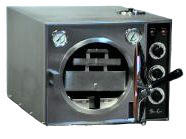COSMETOLOGY
1) Every school shall have and maintain in good working
condition appropriate and adequate equipment for its entire student
body. The following equipment is the minimum equipment required
for a school and, unless otherwise noted, for every 12 students
enrolled in a manicuring course:
· 12 manicuring tables with lamps, drawers and chairs/stools
· 12 wet sanitizers
· 1 dry sterilizer
· 1 wet hospital grade sterilizer
.03: Equipment and Hygiene Procedures
(13) All permanent waving equipment, nets, clips,
pins, rollers, brushes, combs, clippers, scissors, razors, tweezers,
comedon extractors, cape coverings, files, spatulas, applicators
and any other item which comes in contact with a patron or model
must be thoroughly sanitized after each and every separate use.
The use of any implement that cannot be sanitized is prohibited.
(14) After cleansing and sanitizing, all equipment
must be kept in sanitary containers, cabinets or sterilizers. Dry
sanitizer must be used in drawers.
(17) One of the following methods must be used to
sanitize instruments and equipment after use on any patron or model:
(a) Physical Agents.
1. Boiling water at 212°F for 20 minutes.
2. Steaming dry heat.
3. 70% grain or denatured alcohol for at least ten minutes.
4. Ultra-violet rays in an electrical sanitizer.
(b) Chemical Agents.
1. Antiseptics and disinfectants (hospital grade required).
2. Vapors, formalin and steri-dry.
(c) Bleach.
1. Mix one part bleach to ten parts water (e.g., four ounces bleach
to 40 ounces water; any stronger could rust metal implement). The
method to be used is as follows: Rinse the implements in water first,
then immerse the implement in the bleach solution, shake the implement
in the bleach solution, repeat the rinse/immersion/shake process
described, rinse the implement in water a final time and wipe the
implement dry with a clean cloth or paper towel. A hair dryer may
be used to ensure that metal implements are dry and less apt to
rust. Place implement in a closed cabinet or disinfectant solution.
This procedure applies to plastic, metal, steel, or rubber implements.
This is the recommended infection control procedure of the Centers
for Disease Control regarding all bloodborne pathogens, which includes
HIV infection.
(18)
(a) In cosmetology salons, there must be at least two covered waste
receptacles and at least one air-tight container for storing sanitized
instruments. Dry sanitizer must be used in drawers. There must be
one shampoo bowl for each station of three licensees or less. Said
bowls are to be used for cosmetology services only. There must be
at least one dryer and one manicuring table in each cosmetology
salon. Shampoo boards must be washed and disinfected on both sides
after every shampoo.
(b) In manicuring salons, there must be at least one sink which
must be in addition to the sink(s) located with the toilet and handwashing
facilities. There must be at least two covered waste receptacles
and at least one air-tight container for storage of sanitized instruments.
(c) In aesthetics salons, there must be at least one sink which
must be in addition to the sink(s) located with the toilet and handwashing
facilities. There must be at least two covered waste receptacles
and at least one air-tight container for storage of sanitized instruments.
http://www.mass.gov/dpl/boards/hd/cmr/24003.htm#3.03


